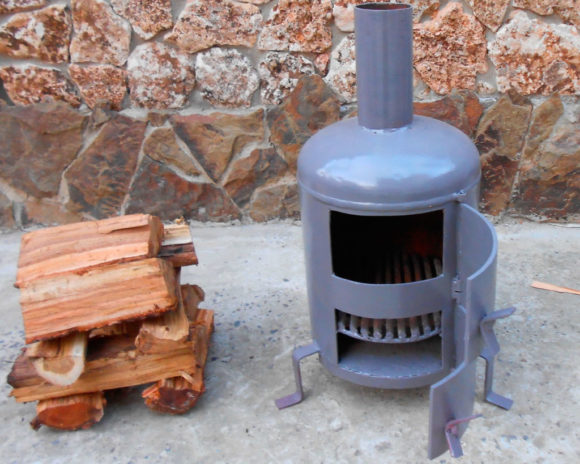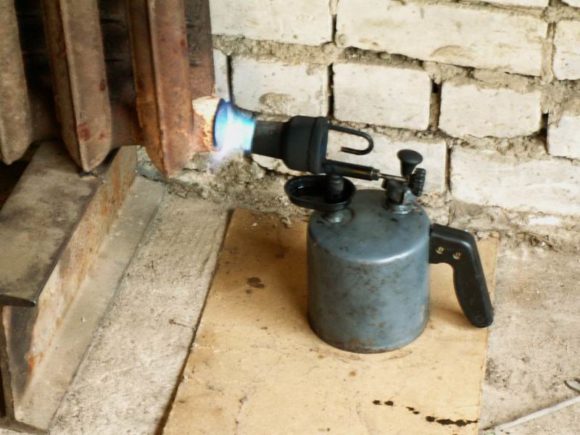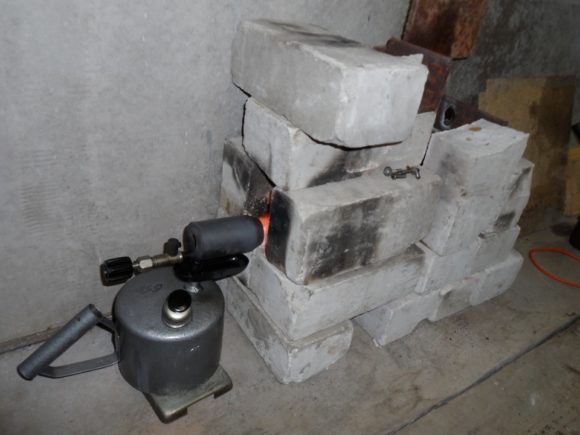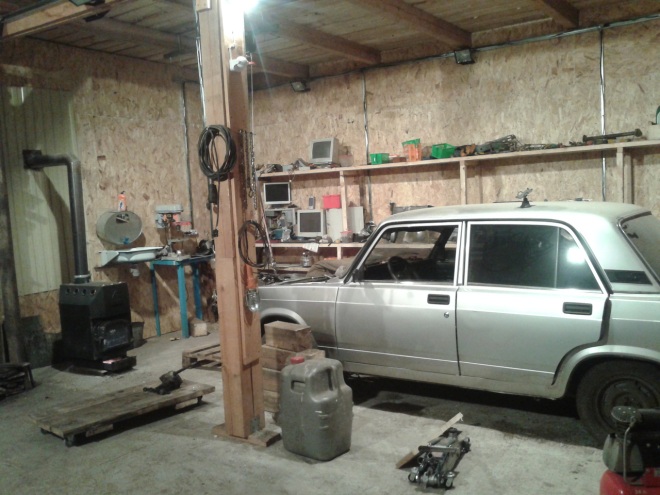Heating a garage without electricity helps reduce energy consumption and have alternative sources of heating. There are different types of garage heaters that do not need electricity. The choice of fuel helps control the cost of heat supply. The ability to heat the garage in winter with your own hands without electricity allows you to use the garage for work in the cold period of time.
Content
Types of fuel for heating
Warm the garage, possibly using various types of fuel. Each of them is distinguished by availability, expense and cost. An important factor is the environmental friendliness of the fuel, which helps to preserve nature in a clean atmosphere. 3 main types of fuel:
- propane;
- natural gas;
- solid fuel.
Propane is a synthetic gas, a product of oil refining. It is operated in a state of liquefied gas. It is widely used by the population in everyday life, especially for space heating. Gas is transported in volumetric cylinders. There it is stored in a concentrated liquid state. The propane cylinder and heater are communicated with a special gearbox through which gas is supplied. Through the reducer, the gas is converted to its original state and ignited on the heating element, distributing heat.

Natural gas is a product of the decay of fossil deposits. Consists of pure untreated methane. It is delivered in a gaseous state. The process of its transmission takes place through pipes from the central gas station, as gas is contained in huge gas storages. Natural gas is cleaner than synthetic.
Solid fuels are sold in the form of wood, coal, peat and shale. For independent heating, the first two types are used. In the economic approach, straw or husk is used as solid fuel. It is considered a “dirty” look, as it requires the removal of the resulting smoke outside. The furnaces operating on it constantly need to be cleaned of soot and combustion products.
The main difference from using electricity for heating is that gas and solid fuel are cheaper resources. This is suitable for those who are used to keeping a budget economically. The use of non-electric fuel allows you to autonomously heat the garage.
Pros and Cons of Fuel Types
The choice of fuel depends on personal choice. In making the final purchase decision, knowledge about the pros and cons of each heating material helps. Each owner is interested in heating the garage inexpensively and effectively.
| Type of fuel | pros | Minuses |
| Propane | Cost effective. Safe source of energy. Ecologicaly clean. Heats large areas. Mobility rearrangement of propane. | The purchase of fuel is difficult, as it is not always available in stores. Propane does not work at low temperatures. Cold compresses the gas in the tank. Propane heaters are highly flammable. Damaged tanks - risk of fire. |
| Gas | Natural gas is cheaper than synthetic. Does not pollute land and water. Burning natural gas produces less carbon dioxide in the environment. | Gas is flammable. A gas leak is difficult to detect due to lack of smell. Natural gases can emit greenhouse gases. |
| Solid fuel | Availability of materials. Low price. Resistance to heat.
| Additional storage space required. The need to regularly refuel and clean the stove. A waste of energy in the preparation of fuel. |
Gas and firewood are available in the winter, when most often there is a need for heating the garage. This makes it possible to work in a heated room at the right time.
Storage of firewood should be in a place protected from rain. The dampness of wood affects the rate of kindling of the furnace.
Types of gas heaters

Depending on the principles of work, they choose the type of heater, which will cost cheaply and at the same time cope with its tasks and functions.
Gas heaters operating on both synthetic and natural gas are available in two types:
- convectors.
- non-volatile gas boilers.
The choice of one of them is determined by the characteristics necessary for the owner. Each of the heaters will heat the room, taking into account its dimensions and the size of the area.
Convector - a heating device that provides heat flow through convection, moving warm air up. Due to its lightness, heated air rises, while cold air goes down, continuing to heat from a heat source.
Gas convectors are located on the floor or on the wall. From the point of view of efficiency, the location on the floor heats the room faster. Convectors of this type are steel and cast iron. Cast iron have more advantages, because cool more slowly, keeping warm longer. For the operation of the device, an influx of fresh air and the removal of combustion products are necessary. This is achieved by means of a pipe facing the street, in which air is convected. In it, fresh air is supplied and inert carbon dioxide is released along with steam. Heating can be made constant if the gas supply valve is not blocked. Ignition is carried out by a button, a piezoelectric element and a pilot burner, from which the main burner ignites.
Electron-independent gas heating boilers are gas-fired heating boilers that do not use electricity. Non-volatile gas boilers provide heat by heating the tank and pipes with water. They are less capacious in heat transfer, but optimally suited for small rooms. They can be used both for heating and for hot water supply.
High ceilings require more energy to efficiently heat the garage.
Solid fuel heaters in the garage
Solid fuel is not consumed as economically in volume as gas. But it is the most affordable for the villagers. In the city, firewood for heating can be purchased cheaply.
Solid fuel heaters are of 2 types:
- heaters;
- boilers for heating water.
Solid-state heaters are found in the form of bourgeois stoves, antique wood-burning stoves and buleryans.
A stove, a potbelly stove, is a vertical or horizontal cylinder with legs, with a pipe coming out. Some types of stoves have a hob. You can make a potbelly stove yourself, for example, from an old propane cylinder. The furnace quickly warms up the space. The disadvantage is the loss of part of the warm air through the chimney along with the smoke.

Antique wood stoves are made of bricks with internal corridors to preserve heat. The output of the combustion product is through a chimney. It is convenient to use a valve in the tube - a cast-iron plate, which ensures the preservation of heat in the room. Heats up quickly, and bricks retain heat for a long time.
Overlapping the pipe with a valve is permissible after burning wood. After a couple of hours, open the valve to reduce the concentration of carbon monoxide in the visit.
The Buleryan furnace was first used by Canadian lumberjacks. It has become popular due to the high heating efficiency. Its difference from the potbelly stove is the absence of direct traction.The pipe comes out at an angle of 45 degrees, thereby preserving the heat energy in the room. It is melted by coal and firewood.
Boilers for heating water are a system of a heating furnace, pipes and radiators. To provide heat in the garage, two radiators are enough. The furnace heats the main water tank, which is connected to additional radiators. Water circulates inside due to the temperature difference, and as a result, heating up completely, for a long period of time transfers heat to the outer space.
Safety rules when using autonomous heating
Following safety tips regarding heaters will save life and property. If a leak is suspected, the gas supply to the source must be shut off. The use of lighters, mobile phones and other spark-causing items is not permitted.
Installation of heaters in the area of active movement is dangerous. It is necessary to provide closed access for children and animals to the heating zone. Do not install the heater near flammable objects.
A heater is purchased that is suitable for indoor use. The device must be turned off after the end of its use.
An open flame heater is protected from flammable liquids. Do not leave the heater unattended. Touching a running heater can cause burns. After shutdown, wait until the heater cools down.
The presence of bushes, trees, and straw around a fire chimney can ignite flammable objects with flying sparks.
Non-electric garage heaters are more profitable to buy. They heat the room more efficiently. They give people the opportunity to work in the garage in the winter at any convenient time. Installing autonomous heating will help you enjoy comfortable winter months.





Alas, no comments yet. Be the first!